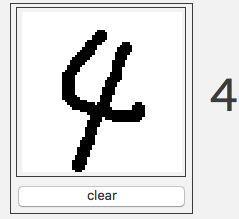The last example in the Classify can be used as a start. lowriniak has translated the code from the cell in the example in the answer here. The example uses logistic regression but the classifier can be changed to a neural network easily:
lenet = NetModel["LeNet Trained on MNIST Data"];
(*Inputs for the canvas and brush size*)
With[
{xsize = 64, ysize = 64, thickness = 3},
(*Makes the dynamic environment for variables to update and track each other*)
DynamicModule[
{
(*Set up the initial graphics objects (so different drawing canvases basically*)
imgdata = ImageData[Image[Table[1, {ysize}, {xsize}]]],
p1 = {53, 23},
p2 = {53, 23},
blank = ImageData[Image[Table[1, {ysize}, {xsize}]]]
},
(*Deploy makes it harder to accidentally delete your interface*)
Deploy[
(*Grid formats the elements*)
Row[{
Grid[{
{
(*EventHandler will watch what your mouse does, you can customise the gestures here*)
EventHandler[
(*This is the thing that the event handler watches*)
Dynamic[
(*This checks the image is valid then constructs it*)
If[
MatrixQ[imgdata],
Framed[Image[imgdata, ImageSize -> {160, 160}]],
None
],
(*This means only one symbol is watched for updates, not all of them*)
TrackedSymbols :> {imgdata}
],
{
(*This defines what click and drag does*)
"MouseDown" :> (
p1 = (p2 = PixelPos[]);
(*A click paints a dot*)
PaintDot[imgdata, p1];
Null
),
(*A drag paints a line*)
"MouseDragged" :> (p1 = p2; p2 = PixelPos[];
PaintLine[imgdata, p1, p2]; Null)
}
]
},
(*Buttons for clearing the canvas and outputting the data. You can make your own actions here*)
{Button["clear", imgdata = blank]}
},
Frame -> True
]
," ",
Style[Dynamic[lenet[Image[imgdata]]],50]}]],
(*Here is where all the painting tools are defined*)
Initialization :> {
(*This finds the mouse position in the graphics and rounds it to the nearest pixel (I think)*)
PixelPos[] := Replace[
MousePosition["Graphics"],
{{ i_, j_} :>Round[{ysize - j, i}], _ :> None}
],
(*This takes a position {i1, j1} and makes a disk of the data around that point of radius 2.5 into 0 values (i.e. black)*)
Attributes[PaintDot] = {HoldFirst},
PaintDot[data_Symbol, p : {i1_, j1_}] := Block[
{dimx = Length[First[data]], dimy = Length[data]},
Do[
If[
EuclideanDistance[N[{i, j}], N[p]] < (thickness*(3/4)),
Part[data, i, j] = 0.
],
{i, Max[i1 - thickness, 1], Min[i1 + thickness, dimx]},
{j, Max[j1 - thickness, 1], Min[j1 + thickness, dimy]}
]
],
(*This takes a start and end point, interpolates between them, and makes a line of thickness defined in the With statement as with PaintDot*)
Attributes[PaintLine] = {HoldFirst},
PaintLine[data_, {i1_, j1_}, {i2_, j2_}] := Block[
{dimx = Length[First[data]], dimy = Length[data], indices, ib, ie, jb, je},
indices = interpolatePoints[N[{i1, j1}], N[{i2, j2}], (thickness*(3/4))];
{ib, ie} = Sort[{i1, i2}];
{jb, je} = Sort[{j1, j2}];
{{ib, jb}, {ie, je}} =
Transpose[
{Clip[#1, {1, dimy}], Clip[#2, {1, dimx}]} & @@ Transpose[{{ib, jb} - thickness, {ie, je} + thickness}]
];
Quiet[Do[
If[
Min[Map[EuclideanDistance[N[{i, j}], #] & , indices]] < (thickness*(3/4)),
Part[data, i, j] = 0.
],
{i, ib, ie},
{j, jb, je}
]];
Null
],
(*This checks how far apart two points are and if they are further than 3 pixels apart, breaks up the line into segments of length 3*)
interpolatePoints[start_, stop_] := Module[
{dist, unit},
dist = N[ EuclideanDistance[start, stop]];
If[
dist < thickness,
Return[{start, stop}]];
unit = Normalize[stop - N[start]];
Append[stop][Table[start + i unit, {i, 0, dist, thickness}]]
],
(*This I think does the same as before but with a generalised step size*)
interpolatePoints[p1_, p2_, r_] := Module[{d, v},
d = EuclideanDistance[p1, p2];
If[d < 2 r, Return[{p1, p2}]];
v = Normalize[p2 - p1];
Developer`ToPackedArray[
Append[p2][Table[p1 + i v, {i, 0., d, r}]],
Real
]
]
}
]]

It runs smoothly on my 4-year-old macbook pro.


URLFetch::invhttp: Transferred a partial file.and can't run the example? $\endgroup$